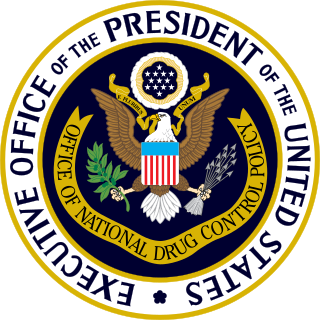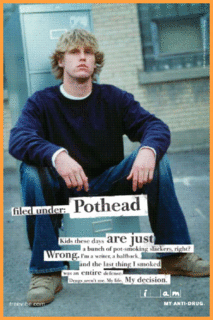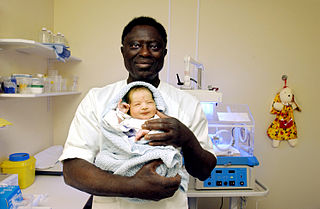
The Office of National Drug Control Policy is a component of the Executive Office of the President of the United States.
Gateway drug theory is a comprehensive catchphrase for the theory that the use of a psychoactive drug can be coupled to an increased probability of the use of further drugs. Possible causes are biological alterations in the brain due to the earlier drug and similar attitudes of users across different drugs. Scientific investigation of the possible causes is considered important for health policy concerning education and law making.
The Multidisciplinary Association for Psychedelic Studies (MAPS) is a membership-based 501(c)(3) organization working to raise awareness and understanding of psychedelic substances. MAPS was founded in 1986 by Rick Doblin, and is now based in Santa Cruz, California.

Smokeless tobacco is a tobacco product that is used by means other than smoking. Their use involves chewing, sniffing, or placing the product between gum and the cheek or lip. Smokeless tobacco products are produced in various forms, such as chewing tobacco, snuff, snus, and dissolvable tobacco products. Smokeless tobacco products typically contain over 3000 constituents. All smokeless tobacco products contain nicotine and is therefore highly addictive. Quitting smokeless tobacco use is as challenging as smoking cessation.
College Health is a field of medicine that exclusively deals with the medical care of college age students. Many colleges and universities campuses offer some sort of student health service, but there is wide variability in the healthcare resources available from campus to campus, with models of student health ranging from first aid stations employing a single nurse to large multi-specialty clinics with hundreds of employees. The vast majority of college health services are set up as service units rather than academic departments. The educational aspect of college health is sometimes referred to Health Promotion in Higher Education.
The Youth Risk Behavior Survey (YRBS) is an American biennial survey of adolescent health risk and health protective behaviors such as smoking, drinking, drug use, diet, and physical activity conducted by the Centers for Disease Control and Prevention. It is one of the major sources of information about these risk behaviors, and is used by federal agencies to track drug use, sexual behavior, and other risk behaviors.
The Drug Resistance Strategies Project (DRS), a program funded by the National Institute on Drug Abuse (NIDA), teaches adolescents and pre-adolescents how to make decisions and resist alcohol, tobacco, and other drugs (ATOD).

An association between tobacco and other drug use has been well established. The nature of this association remains unclear. The two main theories, which are not mutually exclusive, are the phenotypic causation (gateway) model and the correlated liabilities model. The causation model argues that smoking is a primary influence on future drug use, while the correlated liabilities model argues that smoking and other drug use are predicated on genetic or environmental factors.

Substance Abuse Prevention, also known as drug abuse prevention, is a process that attempts to prevent the onset of substance use or limit the development of problems associated with using psychoactive's substances. Prevention efforts may focus on the individual or their surroundings. A concept known as "environmental prevention" focuses on changing community conditions or policies so that the availability of substances is reduced as well as the demand.
The CRAFFT Screening Test is a short clinical assessment tool designed to screen for substance-related risks and problems in adolescents. CRAFFT stands for the key words of the 6 items in the second section of the assessment - Car, Relax, Alone, Forget, Friends, Trouble. As of 2016, an updated version of the CRAFFT known as the “CRAFFT 2.0” has been released.
Center for the Collaborative Classroom is a nonprofit organization headquartered in Alameda, CA that was founded in 1980 by Eric Schaps. Collaborative Classroom develops and disseminates literacy and community-building programs for use in elementary schools, and literacy, mathematics, and science enrichment programs for use in after-school environments, as well as provides professional development services tailored to each program. Collaborative Classroom develops its programs with the goal of helping schools and after-school sites create caring, supportive learning environments that help all children acquire the academic skills they need to be productive and successful, and as well as build and deepen their understanding of, and commitment to, values such as kindness, helpfulness, personal responsibility, and respect for others.

Smokingamong youth and adolescents is an issue that affects countries worldwide. While the extent to which smoking is viewed as a negative health behavior may vary across different nations, it remains an issue regardless of how it is perceived by different societies. The United States has taken numerous measures, ranging from changes in national policy surrounding youth cigarette access to changes in media campaigns, in attempts to eliminate the use of tobacco products among teenagers. Approximately 90% of smokers begin smoking prior to the age of 18. In efforts to reduce the total number of smokers and negative effects smoking has on society, it is necessary to reduce the number of youth and adolescents who begin smoking.
The Children of Immigrants Longitudinal Study (CILS) was designed to study the adaptation process of the immigrant second generation. Immigrant second generation is defined broadly as United States-born children with at least one foreign-born parent, or children born abroad but brought at an early age to the United States. The original survey was conducted with large samples of second-generation immigrant children attending the 8th and 9th grades in public and private schools in the metropolitan areas of Miami/Ft. Lauderdale in Florida and San Diego, California. Conducted in 1992, the first survey had the purpose of ascertaining baseline information on immigrant families, children's demographic characteristics, language use, self-identities, and academic attainment. The total sample size was 5,262. Respondents came from 77 different nationalities, although the sample reflects the most sizable immigrant nationalities in each area. Three years later, corresponding to the time in which respondents were about to graduate from high school, the first follow-up survey was conducted. Its purpose was to examine the evolution of key adaptation outcomes including language knowledge and preference, ethnic identity, self-esteem, and academic attainment over the adolescent years. The survey also sought to establish the proportion of second-generation youths who dropped out of school before graduation. This follow-up survey retrieved 4,288 respondents or 81.5 percent of the original sample. Together with this follow-up survey, a parental survey was conducted. The purpose of this interview was to establish directly characteristics of immigrant parents and families and their outlooks for the future including aspirations and plans for the children. In total, 2,442 parents or 46 percent of the original student sample were interviewed. During 2001-2003, or a decade after the original survey, a final follow-up was conducted. The sample now averaged 24 years of age and, hence, patterns of adaptation in early adulthood could be readily assessed. The original and follow-up surveys were conducted mostly in schools attended by respondents, greatly facilitating access to them. Most respondents had already left school by the time of the second follow-up so they had to be contacted individually in their place of work or residence. Respondents were located not only in the San Diego and Miami areas, but also in more than 30 different states, with some surveys returned from military bases overseas. Mailed questionnaires were the principal source of completed data in this third survey. In total, CILS-III retrieved complete or partial information on 3,613 respondents representing 68.9 percent of the original sample and 84.3 percent of the first follow-up. Relevant adaptation outcomes measured in this survey include educational attainment, employment and occupational status, income, civil status and ethnicity of spouses/partners, political attitudes and participation, ethnic and racial identities, delinquency and incarceration, attitudes and levels of identification with American society, and plans for the future.
National Families in Action is a 501 (c) (3) non-profit organization that was founded in Atlanta, Georgia in 1977. Its mission is to help children succeed by empowering parents to create an academic and social environment where children thrive and are protected from substance abuse and other high-risk behaviors. The organization obtained the nation’s first state laws banning the sale of drug paraphernalia. It helped lead a national effort to help parents replicate Georgia’s laws in other states to prevent the marketing of drugs and drug use to children. Along with the Parents Resource Institute for Drug Education (PRIDE) and the National Federation of Parents for Drug-Free Youth, it helped parents form parent drug prevention groups to protect children’s health. Federal officials credit the parent movement with the two-thirds reduction in past-month drug use among adolescents and young adults that occurred between 1979, when drug use among these age groups peaked, and 1992, when their drug use fell to the lowest levels since national surveys began.

The National Youth Anti-Drug Media Campaign is a current domestic government propaganda campaign in the United States conducted by the Office of National Drug Control Policy (ONDCP) within the Executive Office of the President of the United States with the goal to "influence the attitudes of the public and the news media with respect to drug abuse" and of "reducing and preventing drug abuse among young people in the United States".

The use of Cannabis as a recreational drug has been outlawed in many countries for several decades. As a result of long-fought legalization efforts, several countries such as Uruguay and Canada, as well as several states in the US, have legalized the production, sale, possession, and recreational and/or medical usage of Cannabis. The broad legalization of Cannabis in this fashion can have numerous effects on the economy and society in which it is legalized.
Wilson M. Compton is the deputy director of the National Institute on Drug Abuse (NIDA). Before being appointed to this position in 2013, he was the director of the NIDA's Division of Epidemiology, Services and Prevention Research since 2002. He has also served as a member of the DSM-5 Task Force and the Substance Use Disorders Workgroup. Before joining NIDA, he was an associate professor of psychiatry at Washington University in Saint Louis and the medical director of addiction services at Barnes-Jewish Hospital.












